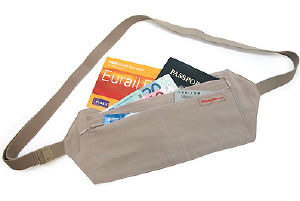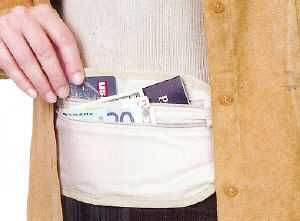Money Belts
by BootsnAll
 Our friend and former colleague, Nick, who used to write what seemed like a gajillion posts a week on the Bali Blog and who knows a thing or two about travel, had a saying when we started BootsnAll that we still like quite a bit. When the conversation would turn to packing for a trip and the methods for carrying your belongings and valuables, Nick would point out the importance of protecting what he called the “crown jewels of travel,” those things that are extremely difficult to replace, and can cause serious problems if missing, should they be stolen or lost.
Our friend and former colleague, Nick, who used to write what seemed like a gajillion posts a week on the Bali Blog and who knows a thing or two about travel, had a saying when we started BootsnAll that we still like quite a bit. When the conversation would turn to packing for a trip and the methods for carrying your belongings and valuables, Nick would point out the importance of protecting what he called the “crown jewels of travel,” those things that are extremely difficult to replace, and can cause serious problems if missing, should they be stolen or lost.
So, what are those crown jewels of travel that Nick likes to talk about?
- Passport and Visas
- Tickets and passes (such as your airline tickets and Eurail pass)
- All cash (except for what you’re going to be using that day), credit cards, traveler’s cheques, etc.
 Now, it’s all well and good to be a careful person and know what your valuables are, but if you don’t protect them it’s a lost cause. So, what’s the best way to secure your crown jewels of travel while you’re on the road? The answer is easy – it’s a money belt.
Now, it’s all well and good to be a careful person and know what your valuables are, but if you don’t protect them it’s a lost cause. So, what’s the best way to secure your crown jewels of travel while you’re on the road? The answer is easy – it’s a money belt.
Money belts (if you’re not familiar with them) are not belts made of money. They are sort of miniature, flat bumbags (what Yanks call “fanny packs,” to much derisive snickering). It’s a zippered pouch, usually made of nylon or a light cotton, with two buckling straps that you wrap around your waist, with the pouch resting against your tummy, tucked inside your pants/skirt, underneath all your clothes.
Why should you carry your valuables in a money belt? Because out of sight is out of mind; even if you get robbed, these items should be safe because they’re not visible to a would-be thief. And you’re also not leaving the crown jewels to the mercy of hotel security or your backpack or someplace where you can’t keep watch and know that they’re still there.
 An alternative option that some travelers prefer is a thin zippered pouch that hangs around your neck underneath your shirt. It’s the same basic idea as the money belt, and if that’s what you’d rather use it’s certainly better than not using anything. But in our experience, these pouches aren’t “invisible” enough – especially in hot climates when you’re just wearing thin T-shirts and not a thick sweater or bulky jacket, you can usually see the money pouch underneath your clothing. And that kind of defeats the whole “hidden” purpose.
An alternative option that some travelers prefer is a thin zippered pouch that hangs around your neck underneath your shirt. It’s the same basic idea as the money belt, and if that’s what you’d rather use it’s certainly better than not using anything. But in our experience, these pouches aren’t “invisible” enough – especially in hot climates when you’re just wearing thin T-shirts and not a thick sweater or bulky jacket, you can usually see the money pouch underneath your clothing. And that kind of defeats the whole “hidden” purpose.
One tip we recommend is to put your valuables into a zippered plastic bag before putting them into your money belt. You’re going to be sweating, whether you’re walking from cathedral to museum or doing a full-on day-hike, and a plastic bag is the only thing that’s going to keep your paper goodies from getting soaked. No one wants to have to deal with damp money when they’re paying for dinner. Trust us.
You can pick up a money belt at most travel stores, gear shops, online shops, etc., usually for just a few dollars (or whatever the local equivalent is). It’s a small investment, but it keeps your cash, your ID, and means of transport safe – which really means it helps keep your entire trip safe. And we think that’s worth a few bucks.
>> But what about other travel documents? Or, is there something to have with you in case something does happen to your passport? Yes, and yes. Here’s more information about different travel documents.